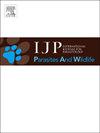人畜共患病风险和保护挑战:尼泊尔奇旺国家公园野生哺乳动物胃肠道寄生虫
IF 2.2
3区 医学
Q3 ECOLOGY
International Journal for Parasitology-Parasites and Wildlife
Pub Date : 2025-01-19
DOI:10.1016/j.ijppaw.2025.101041
引用次数: 0
摘要
胃肠道寄生虫(GIPs)对野生动物的健康和生物多样性构成重大威胁,影响生殖活动、行为、生存和种群动态。确定野生动物的寄生虫感染可以帮助减轻灭绝风险并支持保护工作。本研究调查了尼泊尔奇旺国家公园6种大型野生哺乳动物GIPs的患病率、多样性和人畜共患风险。在2022年12月至2023年4月期间采集新鲜粪便样本,采用直接湿贴装法和浓缩法进行检测。通过对孟加拉虎(Panthera tigris) (n = 7)、亚洲象(Elephus maximus) (n = 9)、独角犀牛(rhinoceros unicornis) (n = 10)、树懒熊(Melursus ursinus) (n = 9)、斑鹿(Axis Axis) (n = 25)和恒河猴(Macaca mullata) (n = 3)等63份粪便样本的分析,共鉴定出19种GIP类型,其中原生动物(Balantioides coli、Isospora spp.和球虫)3种,蠕虫16种,感染率为85.7%。蠕虫(85.7%)高于原生动物(22%)。寄生虫中以线虫(69.8%)居多,其次为吸虫(38.0%)和绦虫(17.4%)。共发现线虫11种,绦虫3种,吸虫2种。多发感染比单次感染更常见。GIPs的高发生率表明,这是一个重大的健康问题,可能影响奇旺国家公园的物种生存和保护工作,突出表明需要采取积极主动的保护和健康监测战略。本文章由计算机程序翻译,如有差异,请以英文原文为准。

Zoonotic risks and conservation challenges: Gastrointestinal parasites in wild mammals of Chitwan National Park, Nepal
Gastrointestinal parasites (GIPs) pose a significant threat to wildlife health and biodiversity, impacting reproductive activities, behavior, survival, and population dynamics. Identifying parasitic infections in wild animals can help to mitigate extinction risk and support conservation efforts. This study investigates the prevalence, diversity, and zoonotic risks of GIPs in six large wild mammals in Chitwan National Park, Nepal. Fresh fecal samples were collected between December 2022 and April 2023 and examined using direct wet mount and concentration methods. By analyzing 63 fecal samples: Royal Bengal Tiger (Panthera tigris) (n = 7), Asian elephant (Elephus maximus) (n = 9), One-horned rhinoceros (Rhinoceros unicornis) (n = 10), Sloth bear (Melursus ursinus) (n = 9), Spotted deer (Axis axis) (n = 25), and Rhesus Monkey (Macaca mullata) (n = 3), we identified 19 GIP types: 3 protozoan species (Balantioides coli, Isospora spp., and coccidia) and 16 helminth species, revealing an 85.7% infection rate. Helminths had a higher prevalence (85.7%) than protozoans (22%). Among helminths, nematodes were the most prevalent (69.8%) followed by trematodes (38.0%) and cestodes (17.4%). Eleven types of nematodes, three types of cestodes, and two types of trematodes were recorded. Multiple infections were more common than single infections. The high prevalence of GIPs indicates a major health issue that could affect species survival and conservation efforts in Chitwan National Park, highlighting the need for proactive conservation and health monitoring strategies for conservation.
求助全文
通过发布文献求助,成功后即可免费获取论文全文。
去求助
来源期刊

International Journal for Parasitology-Parasites and Wildlife
Medicine-Infectious Diseases
CiteScore
3.80
自引率
5.60%
发文量
113
审稿时长
45 days
期刊介绍:
The International Journal for Parasitology: Parasites and Wildlife (IJP-PAW) publishes the results of original research on parasites of all wildlife, invertebrate and vertebrate. This includes free-ranging, wild populations, as well as captive wildlife, semi-domesticated species (e.g. reindeer) and farmed populations of recently domesticated or wild-captured species (e.g. cultured fishes). Articles on all aspects of wildlife parasitology are welcomed including taxonomy, biodiversity and distribution, ecology and epidemiology, population biology and host-parasite relationships. The impact of parasites on the health and conservation of wildlife is seen as an important area covered by the journal especially the potential role of environmental factors, for example climate. Also important to the journal is ''one health'' and the nature of interactions between wildlife, people and domestic animals, including disease emergence and zoonoses.
 求助内容:
求助内容: 应助结果提醒方式:
应助结果提醒方式:


